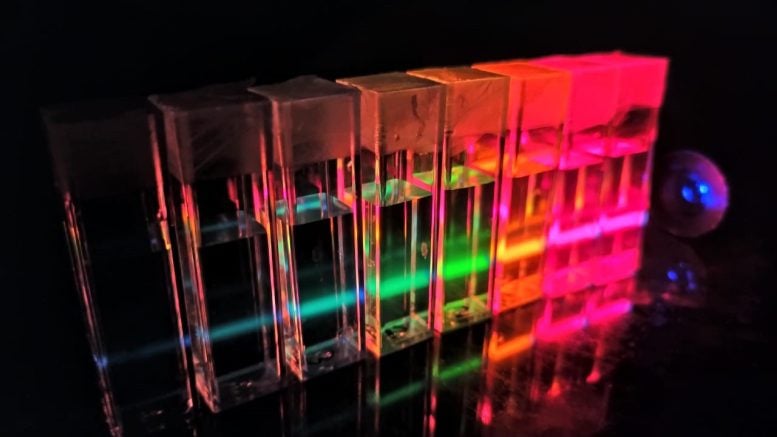
Cadmium telluride (CdTe) quantum dots of different sizes emitting light in response to excitation by UV laser. Credit: Pedro Felipe Garcia Martins da Costa
Researchers monitored the diameter of semiconductor quantum dots in real time by observing the wavelength of the emitted light.
Luminescence is the outcome of a process where an object absorbs light at one wavelength and re-emits it at a different wavelength. During this process, electrons in the material’s ground state absorb light and become excited to a higher energy state. After a specific period, unique to each excited state, the electrons return to lower energy states, including the ground state, and emit light. This phenomenon is utilized in a wide range of technological applications, involving highly efficient and reproducible emitting devices that can be easily miniaturized.
The materials with the highest luminescence efficiency include quantum dots (QDs), currently used in high-resolution displays, LEDs, solar panels, and sensors of various kinds, such as those used for precision medical imaging. Functionalization of the surface of QDs with various types of molecules permits interaction with cellular structures or other molecules of interest for the purpose of investigating molecular-level biological processes.
Quantum Confinement in Quantum Dots
QDs are semiconductor nanoparticles whose emissive characteristics are directly linked to dot size, owing to the phenomenon of quantum confinement. For this reason, monitoring and control of crystal growth during the synthesis of QDs in solution permits intelligent planning of the desired luminescence. In an article published in the journal Scientific Reports, researchers led by Andrea de Camargo, a professor at the University of São Paulo’s São Carlos Physics Institute (IFSC-USP) in Brazil, and collaborators at Kiel University in Germany present a novel approach to the monitoring of QD formation.
“We used cadmium telluride [CdTe] as a model system and controlled nanoparticle growth in a heated aqueous solution via in situ luminescence analysis,” says Pedro Felipe Garcia Martins da Costa, a PhD candidate at IFSC-USP and first author of the article.
The technique enables scientists to see what is happening in the solution in real-time without affecting QD synthesis, so that they can monitor crystal growth by observing the color (wavelength) of the light emitted. “QDs are synthesized by mixing cadmium (Cd2+) and tellurium (Te2-) precursor solutions in the presence of a size control reagent. The temperature is raised and the chemical reaction begins via telluride and cadmium ion clustering. As the reaction proceeds, additional units of CdTe join the cluster spherically in a process known as self-assembly. Nanoparticle size can be estimated thanks to rapid and precise monitoring of the emission frequencies. QDs of CdTe with a diameter of 1-2 nanometers [nm] emit in the blue and green regions of the visible spectrum. Larger QDs, measuring 4-5 nm, emit at lower frequencies, as yellow and red respectively,” says Leonnam Gotardo Merizio, a postdoctoral researcher at IFSC-USP and second author of the article.
Advantages of the In Situ Technique
According to Costa, the novel method has several advantages over the conventional synthesis strategy. “In the conventional technique, you have to take small samples of the solution to measure QD size, but the in situ technique lets you do so as the process is underway, without having to interfere with the reaction medium to take samples so that more spectra can be obtained per unit of time, reaction volume isn’t affected, and unnecessary waste is avoided. The emission color of the QDs of interest can therefore be controlled far more precisely. The equipment that delivers the excitation light via optical fiber at the appropriate wavelength also collects the emitted light and determines its characteristic frequency in the RGB [red, green, and blue] color system. It’s worth noting that control of the RGB system is relevant to image formation in several luminescent devices, such as monitors and smartphone displays,” he explains.
QDs synthesized in this way, he added, were also characterized by means of X-ray diffraction, transmission electron microscopy, ultraviolet-visible absorption spectroscopy, and infrared vibration spectroscopy.
The existence of QDs was predicted theoretically in 1937 by Herbert Fröhlich (1905-91), a German-born British physicist. In the 1980s, Alexey Ekimov (born 1945), in what was then the Soviet Union, and Louis Brus (born 1943), in the United States, independently observed quantum confinement in semiconductor nanoparticles for the first time. In the 1990s, French-American physicist Moungi Bawendi (born 1961) developed significantly enhanced methods of QD synthesis. In 2023, Ekimov, Brus, and Bawendi were awarded the Nobel Prize for Chemistry for their work in the field.
“Quantum confinement gives QDs the capacity to confine electrons in three dimensions, making quantum phenomena more evident and characterizing them as intermediate materials between atoms, molecules, and larger crystalline arrays,” Costa says.
“Many papers have been published on the synthesis of QDs made of CdTe. Our study’s main contribution relates to the development and application of a highly versatile in situ luminescence measurement system. The methodology enabled us to infer the size of the crystalline nanoparticles and to characterize the formation of intermediate compounds in the chemical reactions by in situ association with other techniques that permit chemical and/or structural analysis [FT-IR, Raman, DRX, etc]. This evolution of synthesis optimizes chemical yields and saves energy,” Camargo says.
Reference: “Real-time monitoring of CdTe quantum dots growth in aqueous solution” by P. F. G. M. da Costa, L. G. Merízio, N. Wolff, H. Terraschke and A. S. S. de Camargo, 3 April 2024, Scientific Reports.
DOI: 10.1038/s41598-024-57810-8
The study was funded by the São Paulo Research Foundation.

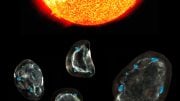

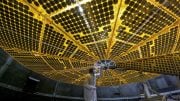
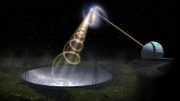


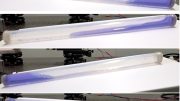

“Quantum confinement gives QDs the capacity to confine electrons in three dimensions, making quantum phenomena more evident and characterizing them as intermediate materials between atoms, molecules, and larger crystalline arrays,” Costa says.
Ask researchers to think deeply:
1. Is quantum high-dimensional spacetime matter or low dimensional spacetime matter?
2. Can quantum matter generate gravity?
3. Can quantum spin?
4. Can topological vortices characterize quantum?
5. Is the spin of topological vortices left-handed or right-handed?
and so on.
Spin is crucial in the evolution of spacetime motion of cosmic matter. Topological vortices are point defects in spacetime. Their rotation is spin. Their interaction is very interesting. Their superposition includes both logical superposition in space-time and factual superposition in reality. Their entanglement includes both surface entanglement and body entanglement. Their deflection methods are endless. In the interaction and balance of topological vortex fractal structures, spin creates everything (including gravity) in the world.
The universe does not make algebra, formulas, or fractions. The universe is a superposition, deflection, and entanglement of geometric shapes, is the interaction and balance of countless topological vortex fractal structures. In these interaction and balance, the past is difficult to change. For the future, some predictable, some unpredictable. But, the present moment is real, certain, and actionable. Physics should not ignore that low dimensional topological fractal structures are the material basis of high-dimensional spacetime.
Scientific research guided by correct theories can help humanity avoid detours, failures, and pomposity. Please witness the exemplary collaboration between theoretical physicists and experimentalists (https://scitechdaily.com/microscope-spacecrafts-most-precise-test-of-key-component-of-the-theory-of-general-relativity/#comment-854286). Some people in contemporary physics has always lived in a self righteous children’s story world. Whose values have been overturned by such a comical and ridiculous reality?
Misguided by the pseudo-scientific theory of Physical Review Letters (PRL), many researchers do not consider the similarities and differences between geometric shapes and physical reality in physics research, but indulge in imagination, and some scholars’ physics research seriously deviates from science, and they are almost unaware of the dirtiness and ugliness. Although mathematics is the language of science, it must be understood correctly.
I hope researchers are not fooled by the pseudoscientific theories of the Physical Review Letters (PRL), and hope more people dare to stand up and fight against rampant pseudoscience.
The so-called academic journals (such as Physical Review Letters, Nature, Science, etc.) firmly believe that two high-dimensional spacetime objects (such as two sets of cobalt-60) rotating in opposite directions can be transformed into two objects that mirror each other, is a typical case of pseudoscience rampant.
Scientific research should be respected, but some people in contemporary physics are not. Please witness the actions of certain individuals and publications. If researchers are really interested in Science and Physics, you can browse https://zhuanlan.zhihu.com/p/643404671 and https://zhuanlan.zhihu.com/p/595280873.
The physical phenomena observed in scientific experiments can never be the natural essence of things. The natural essence of things needs to be refined and elevated via scientific theories. The reason why human being are smarter than other animals is because they are good at thinking. CP violation opened the dirtiest and ugliest era in the history of physics.